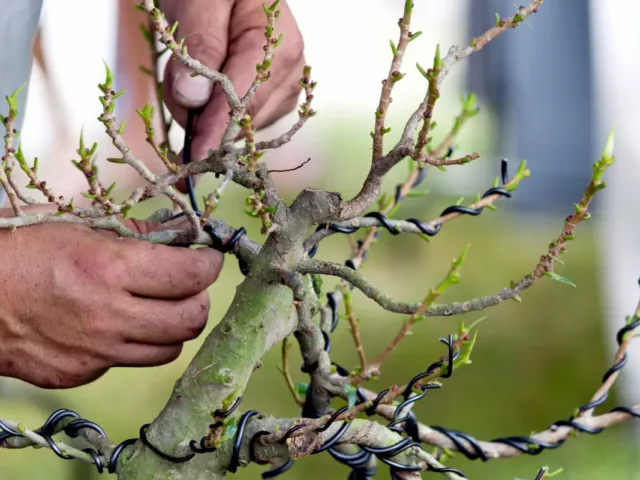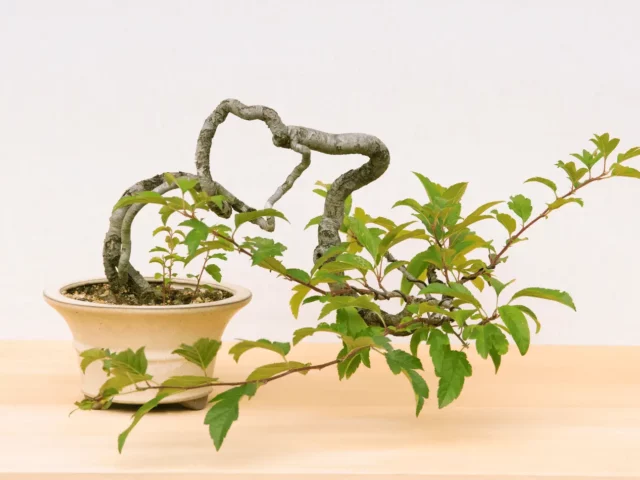Have you ever wondered about the secret to the longevity of bonsai trees? These miniature marvels can outlive generations, with some specimens boasting ages that span centuries, whispering tales of the past into the present.
You might find it fascinating that the lifespan of a bonsai hinges on several pivotal factors, including but not limited to meticulous pruning, optimal soil conditions, and precise watering habits.
As you embark on the journey to uncover the essence of bonsai longevity, you’ll discover that the art of bonsai care is both a science and a form of high expression, promising insights that could transform your approach to these living sculptures.
What makes some bonsai trees endure through the ages while others falter? The answer lies in understanding the intricate balance of care and nature.

Key Takeaways
- Bonsai trees can live for centuries, with some species lasting over a millennium.
- Lifespan depends on species, care quality, and the tree’s genetic heritage.
- Proper care including meticulous watering, soil composition, and regular pruning is essential for longevity.
- Consulting with bonsai experts and selecting hardy species can significantly enhance a bonsai’s lifespan.
The Bonsai Lifecycle
Understanding the bonsai lifecycle reveals that these miniature trees, when nurtured correctly, can outlive many human generations, with their longevity ranging from several decades to over a millennium.
Different species, such as Ficus, possess the potential to live for centuries, given optimal maintenance and environmental conditions. It’s crucial to note that younger bonsai trees generally boast longer lifespans compared to older ones. This indicates a dynamic where the health and vigor of the tree at the beginning stages of growth significantly influence its life expectancy.
Moreover, the pedigree of the bonsai, determined by the health of the mother tree, plays a pivotal role. Trustworthy producers, dedicated to providing quality care, are key to ensuring the long, healthy life of a bonsai, making the choice of source as crucial as the ongoing care in determining a bonsai’s growing journey.
Influencing Lifespan Factors
Several factors critically influence the lifespan of bonsai trees, ranging from genetic heritage to the quality of care they receive. The longevity of your bonsai isn’t merely a matter of chance; it’s deeply rooted in the species selected and the lineage of the mother tree.
Some species, with proper care, can live for millennia, showcasing the profound impact of genetic makeup on lifespan. Young bonsai trees, nurtured by trustworthy producers, often promise a longer journey ahead. These producers ensure the offspring inherit robust health from the mother tree, setting a solid foundation for longevity.
However, the lifespan can vary significantly—from a mere fifty years to several centuries—underscoring the importance of these factors in determining how long your bonsai trees live.
Extending Bonsai Longevity
To extend the lifespan of your bonsai trees, you must adopt meticulous watering practices. Ensure you water them in the morning to facilitate leaf drying and prevent root rot.
Choosing the right soil composition is also crucial. Specifically, selecting soil that drains well plays a pivotal role in maintaining root health and, thus, prolonging the tree’s life.
Moreover, regular pruning is essential. It not only shapes your bonsai aesthetically but also stimulates new growth, directly influencing its longevity.
Proper Watering Techniques
Mastering proper watering techniques plays a crucial role in extending the longevity of bonsai trees, as incorrect hydration can lead to detrimental root conditions. Checking the topsoil’s moisture before watering ensures you don’t overwater, preventing root rot—a common problem that shortens a bonsai’s lifespan.
Proper drainage is essential to avoid waterlogged roots, which can stress the tree, making it susceptible to pests and diseases. Adjusting watering based on the species’ needs, for example, watering a Ficus less during its dormant period, contributes to keeping your bonsai tree healthy.
Using a watering can with a long spout allows for precise, controlled hydration, aligning with the right soil conditions for optimal bonsai tree care. This tailored approach ensures your bonsai can live a longer lifespan, potentially becoming one of the oldest, cherished examples of its kind.
Ideal Soil Composition
After understanding the critical role of proper watering techniques, it’s equally important to focus on the ideal soil composition for bonsai trees to further enhance their longevity.
Well-draining soil, incorporating a balanced mix of akadama, pumice, and lava rock in a 1:1:1 ratio, is fundamental. This precise composition ensures optimal aeration and drainage, which are essential for preventing waterlogging and root rot.
Akadama, a key component, retains moisture and nutrients efficiently, promoting robust root growth. Pumice, by facilitating aeration and drainage, further safeguards against the adverse effects of excess water.
Additionally, lava rock contributes to soil stability, prevents compaction, and enhances drainage, creating an environment where bonsai trees can thrive without the threat of root damage.
Regular Pruning Practices
While proper watering and soil composition lay the foundation for a bonsai tree’s health, regular pruning stands as a critical practice in extending its longevity.
Regular pruning of dead branches not only promotes new growth but also enhances the overall health of your bonsai tree. By maintaining the desired shape and size, you’re contributing to its extended lifespan.
Removing dead or diseased branches is crucial; it prevents the potential spread of issues, supporting the tree’s vitality. Pruning encourages the development of new buds and foliage, resulting in a more compact and aesthetically pleasing appearance.
Adhering to consistent pruning practices is essential for ensuring the health and longevity of bonsai trees, offering you a sense of freedom as you shape these living sculptures to your will.
Oldest Bonsai Trees Worldwide
As you explore the realm of the oldest bonsai trees worldwide, you’ll encounter specimens that not only challenge our understanding of plant longevity but also highlight the meticulous care these ancient living sculptures require.
The recorded ages, such as the over 1,000-year-old Crespi Ficus and the atomic bomb-surviving Hiroshima white pine, serve as benchmarks for what’s possible with dedicated cultivation and preservation.
Analyzing these notable examples provides insights into the advanced techniques and environmental conditions essential for sustaining aged bonsai trees, underscoring the profound connection between human intervention and natural endurance.
Ancient Bonsai Records
Delving into the realm of ancient bonsai records reveals that the Crespi Ficus in Italy, boasting an age of over 1,000 years, stands as the world’s oldest bonsai tree.
This remarkable feat in bonsai tree longevity underscores not just the meticulous care these living sculptures demand but also their resilience throughout centuries.
The Hiroshima white pine, having survived the atomic bomb, and the Pine of the Phoenix in Japan, a 600-year-old giant, further illustrate the extraordinary lifespan of these trees.
Additionally, the Sandai Shogun no Matsu in Tokyo, over 500 years old, highlights the historical significance and cultural reverence bestowed upon these ancient bonsai records.
The record for the most expensive bonsai, an 800-year-old pine, showcases the profound value and dedication invested in nurturing these timeless living artifacts.
Notable Bonsai Specimens
Exploring the realm of notable bonsai specimens reveals a fascinating array of the oldest bonsai trees worldwide, each with its unique history and characteristics.
The Crespi Ficus in Italy, surpassing 1,000 years, stands as the Oldest Bonsai Tree, embodying resilience and meticulous care.
In contrast, the Hiroshima white pine, a testament to survival, flourishes at the United States National Arboretum, having endured the atomic bomb.
Japan’s Pine of the Phoenix dwarfs others at 16 feet tall, showcasing the grandeur of bonsai plants.
Meanwhile, an 800-year-old bonsai pine redefines value, being the most expensive ever sold.
Lastly, the Sandai Shogun no Matsu in Tokyo, over 500 years old, continues to symbolize the enduring legacy of bonsai mastery.
Care for Aged Bonsai
Caring for the world’s oldest bonsai trees demands a nuanced understanding of their unique needs and environmental sensitivities. For bonsai lovers aiming to maximize the life expectancy of a bonsai, it’s pivotal to study these long-living species.
The Crespi Ficus, for instance, has thrived for over a millennium, illustrating the importance of a tailored environment. Similarly, the resilience of the Hiroshima white pine underscores the significance of adaptive care strategies.
To keep your bonsai tree flourishing, consulting a bonsai Resource Center can provide insights into the specific requirements of aged bonsai. Understanding the care behind the Sandai Shogun no Matsu or the Pine of the Phoenix reveals that meticulous attention and dedication can extend bonsai lives beyond what’s typically expected, offering a taste of freedom in nurturing these ancient, living artworks.
Bonsai Growth Timeline
To understand the potential longevity of bonsai trees, it’s essential to examine their growth timeline, which varies significantly across species and is influenced by both genetic and environmental factors.
The lifespan of these miniature trees can stretch from decades to centuries, with records of some species like Ficus thriving for over a thousand years under optimal care and maintenance. This remarkable longevity isn’t just a testament to the resilience of bonsai trees but also highlights the crucial role that species selection, meticulous care, and suitable growing conditions play in their life expectancy.
Historical evidence underscores instances where bonsai trees, through generations of proper care, have surpassed the typical lifespan, proving that with the right attention, these living art pieces can become centennial legacies, embodying centuries of history and care.
Optimal Bonsai Care Practices
Achieving the remarkable longevity of bonsai trees necessitates adhering to a set of precise care practices, which include optimal watering, fertilization, and pruning techniques.
Proper care and maintenance are pivotal, as bonsai trees can thrive for centuries, with lifespans ranging from 50 years to over a thousand years.
Importantly, younger bonsai trees, when meticulously nurtured, tend to outlive older trees, underscoring the significance of early and consistent care.
The health of the mother tree also plays a critical role, influencing the longevity of offspring bonsai trees.
Trusty producers, who are committed to the welfare of these miniature marvels, are key to ensuring their long-term health and vitality.
Thus, dedicated maintenance is your gateway to becoming a custodian of these ancient, living artworks, promising longevity and preserving their legacy for generations.
Bonsai Species for Longevity
Selecting bonsai species such as Cedar, Cypress, Pine, Ficus, and Maple, known for their remarkable longevity, can significantly enhance the lifespan of your miniature tree. These species, celebrated for their resilience, have the potential to thrive for centuries under meticulous care.
Incorporating hardy varieties like Azalea, Ficus, and Juniper into your collection further increases the chances of achieving prolonged vitality. Before making a selection, delving into the specific care requirements of each species is crucial to ensure its compatibility with your lifestyle and environment.
The existence of a Ficus bonsai in Crespi, Italy, aging over 1,000 years, exemplifies the profound longevity attainable with dedicated nurturing and an informed choice of species.
Conclusion
In conclusion, you’ve learned that bonsai trees, with diligent care, can surpass the average lifespan, thriving for centuries. Factors like the health of the progenitor tree, meticulous nurturing, and optimal environmental conditions significantly influence longevity.
Embracing practices such as regular pruning, appropriate soil choice, and conscientious watering can extend their lives remarkably. By selecting species known for longevity and adhering to precise care guidelines, you can cultivate bonsai trees that endure, becoming timeless natural treasures.






